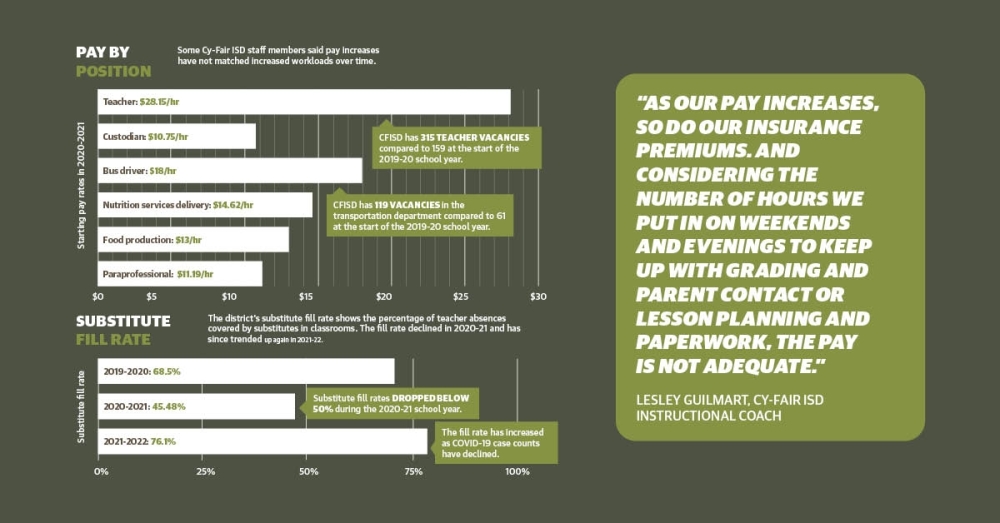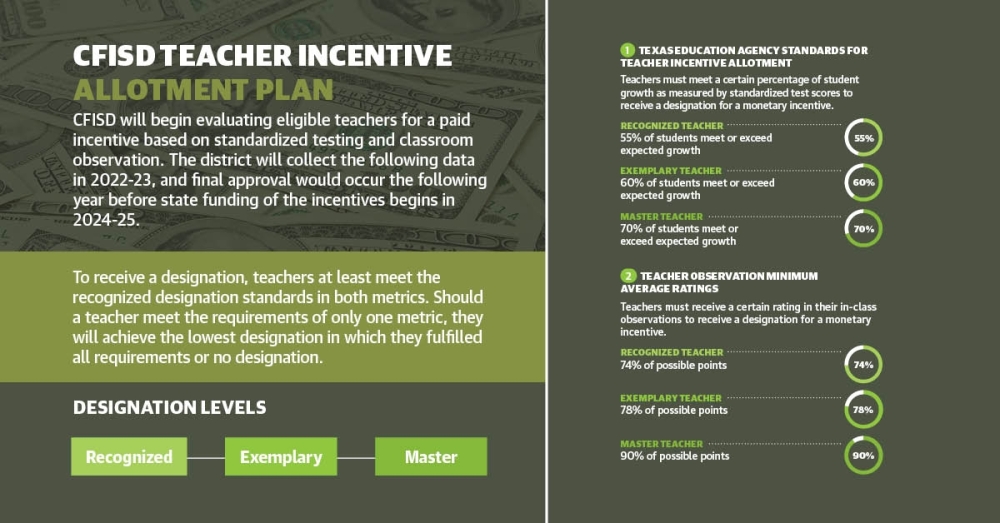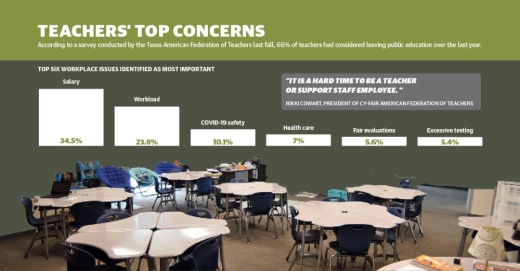While staffing shortages in Cy-Fair ISD have been an issue for years with nearly 800 vacancies districtwide at the start of the 2019-20 school year, CFISD officials said the COVID-19 pandemic has exacerbated these issues. The district’s greatest needs are classroom teachers, special education teachers, instructional paraprofessionals, bus drivers, food service workers and custodians.
“It is a hard time to be a teacher or support staff employee,” said Nikki Cowart, president of the Cy-Fair AFT. “We have been working through a global pandemic with ever-changing rules and guidelines."
As of late February, there were 315 teacher vacancies in CFISD—up from 302 at the start of the school year and 159 at the start of the 2019-20 school year.
The Texas AFT reported 45% of teachers desired higher pay; 35% wanted their workloads lessened; and 8% were concerned about safety inside schools.
In addition to teachers, other school staff have also faced increased pressure. Bus drivers lost routes at the start of the pandemic and had to combine them when students returned, while custodians had to use more rigorous sanitation procedures for the same amount of pay, according to Lesley Guilmart, an instructional coach at Cy-Fair High School.
With these issues continuing to pile up, teachers, staff and education advocates agreed compensation and workloads must be addressed.
Compensation and burnout
Teachers and other CFISD staff members have voiced their concerns to the district during monthly school board meetings. CFISD teacher Carol Campbell explained her concerns for the safety of students and employees at the Feb. 14 board meeting.
“Last year during the height of the pandemic, our rooms were thoroughly cleaned and sanitized each day to protect us from the spread of COVID. We even had plastic shields to help slow the spread of air particles,” Campbell said. “This year, it is as if no one is concerned about the health of our students or staff. We have two custodians to clean a building that is over 200,000 square feet.”
She said custodial workers have left the district due to low pay, which according to a recent job posting on CFISD’s website, starts at $10.75 per hour.
As part of the district’s 2021-22 budget, the board approved 5% salary increases and a $500 stipend at the end of each semester for hourly employees in addition to setting the starting teacher salary at $58,500. While trustees have not yet discussed specifics for fiscal year 2022-23, the board typically approves budgets in June.

Guilmart said teachers and paraprofessionals have seen pay raises end up going toward rising health insurance premiums, which increased by about 62% from 2017-22 for individual employees, according to district data.
She also said she believes compensation increases do not necessarily account for the amount of work demanded.
“Even before the pandemic on a yearly basis, we see an increase in our job expectations and work outside of contract hours with no meaningful increase in pay,” she said. “As our pay increases, so do our insurance premiums. And considering the number of hours we put in on weekends and evenings to keep up with grading and parent contact or lesson planning and paperwork, the pay is not adequate.”
The extra work educators are putting in daily has led many to experience burnout, according to Guilmart. Robert Long III, senior regional advocacy director with statewide nonprofit Raise Your Hand Texas, said he believes the state’s accountability system is another factor playing into teacher burnout.
While the pandemic forced teachers to change the way they delivered their lessons, Long said the state placed the same pre-pandemic expectations on students and teachers when it came to performance on standardized tests. The State of Texas Assessments of Academic Readiness kicked off in February and will continue through April in CFISD.
“Our Texas accountability system has placed undue stress on teachers because they’re expected to keep students at this high academic level when many are dealing with issues that we can’t even imagine. We are talking about ... broadband issues, socio-emotional issues from being isolated, not having human contact, [parents’] job insecurity, food insecurity,” Long said.
Seeking solutions
Despite the added pressures the pandemic has brought on CFISD staff, Long and Guilmart both commended district leaders for innovating to provide relief.
In addition to pay raises since the start of the pandemic, the board has also approved additional paid COVID-19 leave days for employees and work days to give educators time to plan while students take advantage of holidays. Guilmart said administrators have also offered to give teachers a break when substitutes have free periods and brought in treats to boost morale.
At the same time, with a districtwide substitute fill rate of 76.1%, Guilmart said teachers often have to cover classes for their colleagues during their free periods to fill in the gaps.
Superintendent Mark Henry commended Transportation Director Kayne Smith at the February board meeting for filling in for bus drivers himself. As of early March, the district reported 119 vacancies in the transportation department.
One new local business, Taxi Mom, began servicing portions of CFISD earlier this year with a fleet of van-driving moms as an alternative option to riding school buses. Franchisee Lisa Hassbrock said she has heard grumblings from parents who were dissatisfied with how long it was taking their children to get home from school.
Guilmart agreed the district’s transportation burden grows heavier weekly.
“So we have students waiting in the cafeteria until I guess a bus can come back from its first route and pick them up,” Guilmart said. “We’ve had elementary school students crammed into buses during COVID. And those buses [take] a really long time to get these little kids home because they have so many different stops because they’re having to combine bus routes.”
At the state level, the Texas Education Agency announced the creation of a Teacher Vacancy Task Force on March 10 that will bring together superintendents, teachers, human resource officers and other stakeholders from districts across the state to address staffing shortages statewide.
Later that day, the CFISD board heard a plan drafted by a CFISD committee to implement the state’s Teacher Incentive Allotment at its March meeting. If approved by the state-selected review committee, the plan would reward teachers with high marks on classroom observations and positive growth on students’ STAAR scores. The plan is slated for submission April 15.
During the 2022-23 school year, there will be data recorded to study the effectiveness of CFISD’s districtwide plan, which will later be submitted to the state’s committee for review and final approval or rejection of the plan.
Aside from statewide initiatives, Long encouraged people to get involved by appealing to their state representatives to keep education reform on their agendas ahead of the next legislative session in 2023.

Turning to 2022-23
As the school year nears a close, administrators continue to work to fill vacant positions for next school year. These efforts include the April 28 career fair at the Berry Center, partnerships with universities, and advertising job postings online and throughout the community, officials said.
While district officials said they remain hopeful about the effectiveness of their hiring and retention efforts, some experts said they believe change needs to happen before teachers are willing to return to the classroom.
“I think in order to see vacant positions being filled again, there definitely needs to be a movement to recruit teachers to show them that they are supported,’’ said Shamim Arastu, professor of education at Lone Star College-CyFair. “That they will get assistance to help in schools ... [and] that the teachers will get support to help their students that have needs.”
These roles have the potential to be filled by new teachers close to home. LSC-CyFair reported 291 graduates over the past five years were awarded an Associate of Arts in teaching degree.
“I think that that motivation is something that is the same for those who are passionate about entering the nursing field: They want to help others,” Arastu said. “They love those ‘aha’ moments that they can see and know that they were a part of that. They want to make a difference.”
Arastu explained some students start their education careers at LSC-CyFair but transfer to four-year universities after completing their core courses. Should prospective teachers opt out of attending a four-year university, they can use the associate degree from LSC-CyFair to teach after getting their teaching certifications.
With these options at people’s disposal, Arastu said she hopes to see the status of education as an occupation be elevated in the coming years.
“I think education is a field that always is going to have a need,” Arastu said. “And I’m hoping that the deficit in some areas becomes less and less as more people realize the importance of becoming an educator and becoming an agent of change and how important their profession is.”





